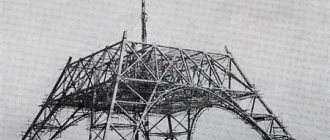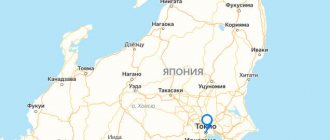Tokyo Metro: features, metro map: Tokyo metro lines and stations.
- Last minute tours
around the world
The Tokyo metro is the largest in the world in terms of the number of passengers carried, with 10 million people using its services every day. The Tokyo Metro consists of two independent lines, Tokyo Metro and Toei. The two networks are completely separate. To transfer from the line of one operator to the line of another, you need to buy a second ticket or a special ticket with the possibility of transfer. Only passengers with PASMO electronic transport cards, a Common One-day Ticket and a single Tokyo Combination Ticket can travel safely on all lines.
- Tokyo metro map in Russian
Using the Tokyo metro is convenient even for foreigners: station names are announced in English and Japanese, and all cars have electronic displays. Metro maps provide information about which train car is best to sit in for a convenient transfer further along the route. Trains run on schedule and at high speed. The hub stations connect the Tokyo subway with commuter train lines. The metro is open from approximately 5 am to 1 am.
In the Tokyo subway, special people work to help passengers squeeze into filled cars - oshiya.
Tokyo subway etiquette dictates that passengers refrain from talking on their cell phones while on the train, and it is also polite to switch their phones to silent mode. On some lines there are carriages only for women and children.
General provisions
1.1.
The policy regarding the processing of personal data (hereinafter referred to as the Policy) is aimed at protecting the rights and freedoms of individuals whose personal data is processed by Podzemny Expert LLC, hereinafter referred to in the text as the Operator. 1.2. The policy was developed in accordance with clause 2, part 1, art. 18.1 of the Federal Law of July 27, 2006 No. 152-FZ “On Personal Data” (hereinafter referred to as the Federal Law “On Personal Data”).
1.3. The Policy contains information subject to disclosure in accordance with Part 1 of Art. 14 Federal Law “On Personal Data”, and is a publicly available document.
1.4. The policy states:
- purposes of processing personal data;
- grounds for processing personal data;
- categories of personal data subjects;
- terms of processing and storage of personal data;
- transfer of personal data to third parties;
- information about the processing and security of personal data;
- rights of personal data subjects.
1.5. The operator operates at the address: 192102, St. Petersburg, Fuchika street, no. 4, lit. K, room 16N.
1.6. Olga Evgenievna Korotkova (phone 8(812)3250565, e-mail) was appointed responsible for organizing the processing of personal data.
Terms and definitions used
2.1. Personal data - any information relating to a directly or indirectly identified or identifiable individual (subject of personal data).
2.2. Operator - a state body, municipal body, legal or natural person, independently or jointly with other persons organizing and (or) carrying out the processing of personal data, as well as determining the purposes of processing personal data, the composition of personal data to be processed, actions (operations) performed with personal data.
2.3. Processing of personal data - any action (operation) or set of actions (operations) performed using automation tools or without the use of such means with personal data, including collection, recording, systematization, accumulation, storage, clarification (updating, changing), extraction, use, transfer (distribution, provision, access), depersonalization, blocking, deletion, destruction of personal data.
2.4. Providing personal data - actions aimed at disclosing personal data to a certain person or a certain circle of persons.
2.5. Destruction of personal data - actions as a result of which it becomes impossible to restore the content of personal data in the personal data information system and (or) as a result of which material media of personal data are destroyed.
2.6. Blocking of personal data is a temporary cessation of processing of personal data (except for cases where processing is necessary to clarify personal data).
Purposes of processing personal data
3.1. The operator processes personal data for the following purposes:
3.1.1. for the execution of a contract to which the subject of personal data is a party;
3.1.2. establishing feedback for processing incoming requests from individuals for the purpose of providing information and consulting services, advertising services, including sending notifications and requests;
3.1.3. to promote the Operator’s information services on the market by making direct contacts with the subject of personal data using communication means;
3.1.4. conducting personnel work and organizing records of the Operator’s employees;
3.1.5. attracting and selecting candidates to work for the Operator;
3.1.6. identification of a visitor to the Operator’s website – https://undergroundexpert.info/;
3.1.7. providing website visitors with information about the company and the services provided;
3.1.8. to achieve the goals provided for by an international treaty of the Russian Federation or law, to implement and fulfill the functions, powers and responsibilities assigned by the legislation of the Russian Federation to the Operator;
Tokyo Subway Owners
Nowadays the Japanese subway includes 13 lines. Nine of them are operated by Tokyo Metro. This is an important feature because transfers to lines operated by the city government (Toei) almost always require a different ticket. The owners of the subway changed, some of the lines remained in municipal ownership. The last privatization took place in 2004.
The owners try to cooperate in order to provide as much convenience as possible to consumers. Now there are travel tickets on sale that give the right to use the entire metro (for example, the PASMO transport card, the Common One-day Ticket, as well as the Tokyo Combination Ticket, you can use a Suica payment card).
But there is also normal competition between campaigns. Thus, a Toei (municipal company) ticket gives the right to use electricians and buses operated by it.
Grounds for processing personal data
4.1. The legal basis for the processing of personal data is:
4.1.1. Legislation of the Russian Federation in the field of personal data
based on the Constitution of the Russian Federation and international treaties of the Russian Federation and consisting of Federal Law of July 27, 2006 No. 152-FZ “On Personal Data” and other federal laws defining cases and features of the processing of personal data;
4.1.2. consent to the processing of personal data, the conditions of which are confirmed
by the subject of personal data in writing, when working with the feedback form on the Operator’s website, when using the Operator’s website;
4.1.3. any agreements concluded by the Operator, annexes to these agreements.
Terms of processing and storage of personal data
6.1. The processing of personal data is terminated by the Operator upon achievement of the goals of such processing, as well as upon expiration of the period provided for by law, contract, or consent of the subject of personal data to the processing of his personal data. When the subject of personal data withdraws consent to the processing of his personal data, processing is carried out only to the extent necessary for the execution of contracts concluded with him and for the purposes provided for by the legislation of the Russian Federation.
How to ride trains and subways in Japan?
In texts about Japan, I briefly mentioned trains and the JR Pass several times, now I want to once and for all clearly explain how the Japanese railway and subway system work, how to pay for travel, how to build routes and how to save on travel.
In Japan, there is no difference between the city subway, commuter trains and intercity trains; they all work on the same principle. But in Japan there are differences between branches belonging to different companies. Most of the railways are operated by JR – Japan Railways. Relatively speaking, an analogue of our Russian Railways. All other branches are distributed among many private companies. In Tokyo, for example, most subway lines are owned by Tokyo Metro, a smaller number are owned by Toei, and the Yamanote Circle Line is owned by JR. For the client, this means that if your route involves the lines of several companies, then each must pay for the journey separately.
Almost every city in Japan can be reached by JR trains, but most regions also have a parallel local train network that may be slightly more convenient or cheaper. For example, from Osaka to Kyoto it is often more convenient to travel by Hankyu trains, while in the Nikko area it is convenient to use Tobu. Large cities usually have their own local metro or light rail networks.
Subway lines in Tokyo can be distinguished by their names or colors. Pay attention to how they are divided between companies.
Station names are always duplicated in Japanese and English.
The cost of rail travel in Japan consists of two figures: payment for the distance (base fare) and an express surcharge or seat fare. For regular trains you only have to pay the distance fee, for express trains you have to pay both the distance fee and the express surcharge.
Regular trains
The amount of payment for distance is clearly fixed for any pair of stations throughout the company's entire railway network (there are no “zones,” for example), throughout Japan. That is, you can take Akihabara Station in Tokyo, Nara Station in Nara and calculate how much you will have to pay for this distance. Or you can take Akihabara Station in Tokyo and Shinjuku Station in Tokyo. The principle is the same. It doesn’t matter how long you travel, what route, on what day, the price for the distance is always the same (but if you travel by express, you also have to pay separately for the express, more on that later).
To buy a ticket for a short distance (travel within the city and within the nearest couple of prefectures) and a regular train (that is, without an express surcharge), you need to use ticket machines. They have English. There is no need to go to the cash register (and it is not always easy to find).
Another thing is that when buying a ticket from the machine, you are offered price options (for example, “200 yen, 280 yen, 500 yen, etc.”), and not station options. Therefore, before purchasing, you need to figure out how much a ticket will cost and choose the right number. To do this, there are cards with prices at the stations, and on them the stations are often indicated only in hieroglyphs.
The Tokyo station is marked with an arrow on the map - this means that you are there. There is a diagram of branches all around, and under each station the fare in yen is written.
Finding the right station on such a map is a fun experience. ^_^
For trips over long distances or for tickets with a surcharge for express, there are also machines, but I recommend going to the ticket office. It's much simpler and more versatile. There you simply tell the cashier where you want to go, and he shows you on a calculator how much you need to pay. All.
The price for the distance is charged to you as follows: at the entrance to the departure station, you insert your ticket into the receiver, and the system remembers where you sat down. Be sure to take your ticket with you and don’t lose it! At the exit of the arrival station, you insert a ticket, the system calculates the distance and charges the ticket for the distance. If your ticket has been paid for correctly, the turnstile will eat it. If the ticket is for a smaller amount, then you need to pay the difference at the Fare Adjustment machine or to the controller at the station. Therefore, by the way, if you have no time or it’s difficult to figure out how much a ticket should cost, you can simply take the cheapest one, get there, and pay the difference at the exit (the machine itself will calculate how much you owe).
All this is true if you travel with transfers to branches of the same company (there are no turnstiles inside). If you need to change, for example, from JR to Tokyo Metro, then at the exit from the JR station you need to pay JR, and then buy a Tokyo Metro ticket and go to Tokyo Metro. You'll end up with two trips instead of one, but the principle is the same.
In addition, the fee for the distance from one station to another may differ (although not too significantly) depending on which company lines you are traveling on. For example, travel from Narita Airport to Ueno Station in Tokyo on JR trains costs 10 percent more than on Keisei trains.
It's inconvenient to deal with a bunch of tickets from different companies and check fare tables, so the first thing you need to do in Japan is buy yourself a Suica card (sold at JR stations) or a Pasmo card (sold at Tokyo Metro stations). You can put an arbitrary large amount on it (for example, 5,000 yen), and simply touch the turnstile with the card at the entrance to the station and at the exit from the station. The correct amount will be automatically debited. By the way, you can still pay with such cards in Family Mart minimarkets, in souvenir shops at the airport and many other places, so don’t be afraid if you put too much on the card.
To buy a Suica card, you need to find a machine at the station that says Suica. Regular ticket machines may not sell them. It's the same story with Pasmo.
With Suica you can pay almost everywhere, except for the very small village lines, where turnstiles have not yet been installed to accept these cards. Some short lines operate at a fixed price (eg 200 yen). They just don't have enough stations to count the distance. On other lines you need to pay the driver. It's called One Man Car (wanman car).
Wanman Cars operate on the same principle as Japanese buses: at the entrance you need to press a button and receive a piece of paper with the number of the station where you boarded. And at the exit, present it to the driver, and he will calculate how much you owe.
The most difficult case is when you got into a normal Suica station, rode along a regular line, then, without leaving the city, changed to this strange Wanman Car, and you don’t really understand how to pay at the exit. In this case, just show the driver a map, tell him which station you are coming from, and he will resolve the issue. But usually this happens extremely rarely, and when changing to an outdated branch there should be a turnstile that will charge you money for the previous segment.
If you know in advance that at the end of a difficult journey you have a Wan Man Car, just buy a paper ticket for the entire amount of the trip. You can give it to the driver, and he will understand that you have already paid for everything and do not owe anything.
Express
For which trains do I need to pay an extra express fee? There is never a need for Local (they stop at every station) and Rapid (Special Rapid, Section Rapid, etc. - they skip some stations). You always need to take the Shinkansen (super express). However, there are a lot of trains called Express (Limited Express, etc.), for some you don’t have to pay extra, for others you have to. For example, you have to pay extra for Narita Express, but you don’t have to pay extra for Narita Access Express.
Additionally, although Rapid class trains in regular carriages do not require an express surcharge, they may have first class carriages at a surcharge.
A regular train can also have a green car, so don’t get into one by accident.
The easiest and most practical way to understand whether you need to pay extra is to build routes online, because all the necessary information will be shown there. All transfers, train names, travel times and prices, of course.
There are two such services - Hyperdia and Japan Transit Planner. Japan Transit Planner also has a convenient application in the Russian App Store. You can also try NAVITIME.
For example, if you take and build a route from Akihabara to Nara, it will turn out like this.
Here the price per distance is 8750 yen. For this money you can travel on regular trains with ten transfers. To do this, in Hyperdia you should go to the search settings and uncheck all types of trains except Local, Express (this is an express train, as a rule, without a surcharge, but you need to monitor the search results), Walk. But it’s better to do this only over short distances.
By the way, the same service can be used to calculate the cost for the distance from station to station and buy a ticket for the correct amount (if you buy tickets and do not use a card).
The express surcharge in the screenshot is 5,900 yen. It says Seat Fee, and in fact this is a payment for comfort (in express trains there are comfortable soft chairs). But on the screenshot there is also the word Unreserved (which means: with such a ticket, you may have to stand).
The fact is that on express trains (including shinkansen) there are three types of tickets: unreserved, reserved and green. And, accordingly, three types of cars: unreserved, reserved and green. In carriages with unreserved tickets, people take seats on a first-come, first-served basis; there are no fixed seats on the ticket. And if you really want to leave urgently, then you can stand. Even in the Shinkansen. In reserved, each ticket corresponds to a seat. Green is the same reserved, but in first class carriages with increased comfort.
In shinkansen on lines where trains run frequently, you can safely take unreserved. You can’t fit into one while sitting, but you’ll fit into the next one in 15 minutes. On lines where trains rarely run, it is better to take reserved.
The distance ticket in Japan looks very simple, there is a buying station and a price.
A ticket with a surcharge for express is approximately twice as large, and there is more information there.
If you have a reserved ticket, it is important to sit in the correct carriage (and seat, of course). If you have an unreserved ticket, you can board any carriage marked as unreserved. Usually there are signs about this at the station, plus there are also voice announcements before arrival, in which they call unreserved cars.
An unreserved ticket is not tied to a specific time; you can take any of the same trains in the same direction.
Tickets with a surcharge for express are checked by inspectors on trains, and they run quite often.
If your trip involves traveling on several trains at once (for example, the Shinkansen from Tokyo to Hakata, and then the limited express to Yufu), then you can name the end point of the route right at the first ticket office, and they will sell you two tickets at once. Even if these are branches of different companies, by the way. You just need to clearly say the name of the end station and answer the question “reserved or unreserved?” If it is not an express train that goes to the final point of the route, then you will be given a separate ticket for the distance, and separate tickets with an additional payment for each express train.
You can safely buy train tickets for popular destinations (from Tokyo to Kyoto, for example) half an hour before departure. There are always tickets, and if there are no tickets for the nearest one, then there are tickets for the train in 15 minutes. There is no need to book online in advance.
Another thing is that on unpopular routes the necessary trains may run a couple of times a day and sometimes may suddenly be overcrowded (for example, from Tokyo to Yamagata). In this case, you can buy tickets the evening of the previous day.
In general, the train system in Japan is designed for spontaneous trips without much planning. If you want to book tickets remotely online, then on some lines you can do this - for example, on JR trains in the eastern part of Japan. But these are still not full-fledged online tickets, like Russian Railways. They will then need to be picked up at the ticket office on site. And on most branches you can’t even do that. So if you're worried, just go to the box office on your first day in Japan and buy yourself tickets at least two weeks in advance.
The last but important point: express trains have not only soft seats, but also reclining tables. On such tables it is convenient to eat bento - lunch in a box. It is sold at all stations. Be sure to try this, it is an important experience when traveling in Japan. ^_^
JR Pass
The only downside to Japan's excellent train system is that tickets are too expensive. Getting from Tokyo to Kyoto costs about 17 thousand yen, i.e. about 8-9 thousand rubles.
Therefore, there is an offer especially for tourists - the JR Pass. Priced at around 30k yen, it allows you to travel for a week on all JR trains (as well as JR buses and JR ferries, but there are not many of them) unlimited travel. The exception is the shinkansen of the Nozomi and Mizuho lines (but you will be quite happy with the Hikari and Sakura shinkansen). It’s easy to think that the Tokyo-Kyoto-Tokyo trip alone will already pay for it.
The JR Pass voucher must be purchased in advance abroad. In Russia they are sold by HIS, but can be ordered online with online delivery.
Vouchers are available for 7, 14 or 21 days, regular and Green (i.e. with the right to travel in first class), adults and children (6-11 years old).
When you find yourself in Japan, the voucher must be exchanged for a real JR Pass (by presenting your passport and saying from what exact date you need to activate it). The pass will be valid from the morning of the day of activation until 23:59 of the last day. You can exchange your voucher at major stations and airports. You can exchange it directly in Narita and use it immediately.
With the JR Pass you don't have to go through the turnstiles at all, but instead walk past the ticket inspector at the station and show him your pass. You can also simply board express trains with unreserved tickets and show your pass to the ticket inspector. The same story is on JR Bus (the most useful one is in Kyoto) and on JR Ferry (it goes to Miyajima Island, for example).
Tickets for reserved seats using the JR Pass can also be purchased; to do this, you need to go to the box office, show your pass and get tickets for free. If you are not in a hurry, are traveling in a group, and want to definitely leave on a certain train and sit together, then, of course, issue reserved tickets. If you want to get to the platform faster and you are alone, you can go unreserved.
In addition, although shinkansen from Tokyo to Kyoto run every 15 minutes or more, most of them are Nozomi shinkansen, which are not allowed with a JR Pass. And suitable ones come once every half hour or hour. Therefore, during the sakura season, it is better to buy reserved tickets with the JR Pass a few hours before the trip or in the evening of the previous day. Well, to be completely calm.
There is only one problem with the JR Pass: if you are going to Japan for two weeks, and you take the Pass for one week, then you really want to fit in all the long journeys in that week. Therefore, it turns out that you are motivated to move wildly from place to place. But if you want to go to Kyoto the first week and return the second week without making any other big trips, then the JR Pass for two weeks may not be a good deal.
To accurately calculate whether you need a JR Pass, you can use a special calculator.
There are other local passes in Japan. For example, Seishun 18. And many, many others.
For example, Tokyo Metro has a ticket that allows you to ride the subway for one day for 600 yen.
In all such cases, I recommend doing this: build a complete itinerary for your entire trip without using any passes and calculate the cost, and then look at what passes exist in the region and estimate how much they will save.
If the price is approximately the same, then it is, of course, better to take a pass (especially the JR Pass) - simply because it is a hell of a lot more convenient.
And it’s a great souvenir as a keepsake!
I also recommend reading the materials: – Optimal plan for a trip to Japan – How to live in a ryokan – Plan for a trip to the cherry blossoms
You can find out more about Japan in the telegram channel.
Transfer of personal data to third parties
7.1. To achieve the purposes of processing personal data and with the consent of the subjects of personal data, the Operator provides personal data or entrusts their processing to the following persons:
7.1.1. government agencies;
7.1.2. individuals who are in labor and civil relations with the Operator's counterparties;
7.1.3. to individuals who are in labor and civil legal relations with the Operator.
7.2. In order to fulfill contractual obligations or requirements of federal law, the Operator receives personal data from the following third parties:
7.2.1. Other persons in accordance with a civil law agreement.
7.3. The processing of personal data is carried out in compliance with confidentiality, which means the obligation not to disclose to third parties or distribute personal data without the consent of the subject of personal data, unless otherwise provided by the legislation of the Russian Federation.
Information about the processing of personal data
8.1. The Operator processes personal data on a legal and fair basis to fulfill the functions, powers and duties assigned by law, to exercise the rights and legitimate interests of the Operator, the Operator’s employees and third parties.
8.2. The operator receives personal data directly from the subjects of personal data.
8.3. The operator processes personal data in automated and non-automated ways, with and without the use of computer technology.
8.4. Actions for processing personal data include collection, recording, systematization, accumulation, storage, clarification (updating, changing), extraction, use, transfer (distribution, provision, access), depersonalization, blocking, deletion and destruction.
8.5. Databases of information containing personal data of citizens of the Russian Federation are located on the territory of the Russian Federation.
8.6. The operator has the right to entrust the processing of personal data to another person with the consent of the subject of personal data, unless otherwise provided by federal law.
Such processing of personal data is carried out only on the basis of an agreement concluded between the Operator and a third party, which must define:
- a list of actions (operations) with personal data that will be performed by a third party processing personal data;
- purposes of processing personal data;
- obligations of a third party to maintain the confidentiality of personal data and ensure their security during processing, as well as requirements for the protection of processed personal data.
Be mindful of rush hours
Rush hours are a real problem for transport in large cities. Usually this time is between 8 and 9 am, and also in the evening hours from 17:00 to 18:00. At this time, the load on public transport, especially the metro, is approaching critical. Some of the busiest lines in Tokyo include:
- from Nakano to Shinjuku (JR Chuo Line),
- from Kinshicho to Ryogoku (JR Sobu Line),
- from Kiba to Monsen Nakacho (Tokyo Metro Tozai Line),
- from Kawasaki to Shinagawa (JR Tokaido Line).
In order to give trains the opportunity to leave stations at such times, the Tokyo and Osaka subways even use special teams of “tampers,” employees who literally push passengers into the cars. From the outside it looks funny, but I would not wish anyone to become a participant in such an action.
Information about ensuring the security of personal data
9.1. The operator appoints a person responsible for organizing the processing of personal data to fulfill the duties provided for by the Federal Law “On Personal Data” and the regulatory legal acts adopted in accordance with it.
9.2. The operator applies a set of legal, organizational and technical measures to ensure the security of personal data to ensure the confidentiality of personal data and their protection from unlawful actions:
9.2.1 provides unlimited access to the Policy, a copy of which is posted on the Operator’s website at https://undergroundexpert.info;
9.2.2 in pursuance of the Policy, approves and puts into effect internal local acts;
9.2.3 familiarizes employees with the provisions of the legislation on personal data, as well as the Policy and internal local regulations;
9.2.4 provides access to employees to personal data processed in the Operator’s information system, as well as to their material media only for the performance of job duties;
9.2.5 establishes the rules for access to personal data processed in the Operator’s information system, and also ensures registration and accounting of all actions with it;
9.2.6 assesses the harm that may be caused to personal data subjects in the event of a violation of the Federal Law “On Personal Data”;
9.2.7 identifies threats to the security of personal data during their processing in the Operator’s information system;
9.2.8 applies organizational and technical measures and uses information security tools necessary to achieve the established level of personal data security;
9.2.9 detects facts of unauthorized access to personal data and takes response measures, including restoration of personal data modified or destroyed due to unauthorized access to it;
9.2.10 carries out internal control of compliance of the processing of personal data with the Federal Law “On Personal Data”, regulations adopted in accordance with it, requirements for the protection of personal data, Policy, Regulations and other local acts, including control over measures taken to ensure the security of personal data and their level of security when processed in the Operator’s information system.
Tokyo subway map, subway map
If you are thinking about what to visit in Tokyo, then the Tokyo metro map is of the greatest practical interest. According to data obtained during a statistical study, the metro of the capital of the Japanese state is one of the largest cargo carriers on a global scale. About ten million people use its services every day.
If you come across a Tokyo subway map in Russian (for convenience), you will immediately notice how colorful and confusing it is. This indicates the extreme ramification of lines that cover all areas of the city. The frequency of location of metro stations is clearly visible on the map, which is designed to make use as convenient and accessible as possible for everyone.
A map of the Tokyo metro in Russian clearly shows that it is distributed between two management organizations - Tokyo Metro and Toei. This imposes certain restrictions on free movement, unlike other metros in the world.
At Tokyo stations you can always find a special interactive map that shows how it is more convenient for passengers to transfer from one line to another. It must be taken into account that the lines constantly intersect, forming a confusing train movement pattern. However, the map is quite informative, so the ease of movement quickly becomes obvious.
The Tokyo subway layout is such that all its key stations are connected to other public transport, so it allows easy access to trains of various directions, monorails, high-speed intercity railways, etc. Almost all carriages have heated seats. The Japanese metro is breaking its records. For example, one of Tokyo's stations, Shinjuku, is the second largest station in the world and serves almost two million passengers daily.
There is one more feature in the Japanese subway that is not found anywhere else. This is the presence of special employees whose task is to help passengers get into crowded cars during rush hour. In practice, this means that employees delicately but confidently try to squeeze everyone who wants to go onto the train. Such a co-worker is called Hosea.
Subway cars have their own culture of behavior. It is not customary to use a mobile phone or talk loudly. It is considered a sign of good upbringing if all gadgets are set to silent mode. Authorities take care of women and children by providing separate carriages for them to avoid getting bruised or even broken in the crush. Also for these categories of citizens there is a different fare tariff.
In general, the price of travel directly depends on the distance you are going to cover and the transport company whose line you are using. The Japanese know that it is most economical to purchase a set of coupon tickets at once, because this gives the right to a discount, and such tickets last for three months.
The Tokyo subway map also indicates where you can buy the unlimited travel pass. This choice is made by those who come to the city for a few days, and the ticket is sold upon presentation of a return ticket or passport.
Despite the huge capacity, it is impossible to encounter cases of vandalism in the Japanese subway. Cleanliness and perfect orderliness always reign here.
Rights of personal data subjects
10.1 The subject of personal data has the right:
10.1.1. to receive personal data relating to this subject and information regarding their processing;
10.1.2. to clarify, block or destroy his personal data if they are incomplete, outdated, inaccurate, illegally obtained or are not necessary for the stated purpose of processing;
10.1.3. to revoke his consent to the processing of personal data;
10.1.4. to appeal the actions or inaction of the Operator to the authorized body for the protection of the rights of personal data subjects or in court.
10.1.5. To exercise their rights and legitimate interests, subjects of personal data have the right to contact the Operator by sending personally or with the help of a representative a request containing the information specified in Part 3 of Art. 14 Federal Law “On personal data at the address specified in paragraph 1.5 of this Policy.
How to navigate the Japanese subway
The metro map looks confusing. However, getting comfortable here is easier than it seems. You need to navigate by station numbers and codes. They are identical in all diagrams. For example, E18 is the station encoding. Here “E” denotes the Oedo line, the numbers are the serial number of the station. Subway cars are equipped with electronic displays. They contain messages about stations. In addition, stop announcements are broadcast in two languages: Japanese and English. Chinese is used less frequently.
When entering the subway, you need to look carefully at the logo if you have already purchased a ticket. The sign is usually located in a visible place so that passengers do not get confused. If you have to change from one line to another during your trip, have your ticket ready. It will need to be submitted to automatic control between stations.
The metro is open from five o'clock. Peak loads occur almost immediately. People go to work. The influx of passengers subsides by 9:30. The evening peak occurs from 18-00 to ten. In addition, on Friday the subway is crowded with office workers and other workers traveling out of town after corporate parties. Underground traffic stops at one in the morning. The Tokyo subway carries about 10 million people a day.
Here's what American writer Karin Muller writes about the Japanese subway:
Every weekday, a huge moving wave of men and women with briefcases spills onto the streets of residential areas, flows like a waterfall down the steps of metro stations and breaks up into thin streams, each flowing to its own train. I'm tailgating. We walk to the edge of the platform and with great difficulty squeeze into the crowded train. I find myself in a tight circle of complete strangers. It still amazes me how the Japanese, who generally do not accept public touching, manage to survive this daily invasion of personal space. But even in a crowded carriage, etiquette is everything. A unique code of conduct was developed especially for this occasion to maintain harmony. You must not look other passengers in the eyes. You need to generally pretend that they don’t exist: even if someone sneezed, don’t even think about saying “Be healthy.” The Japanese ignore any behavior that could potentially engage them in conversation, be it a friendly smile or a drunken swagger. They try not to attract attention to themselves, if possible they create some space around themselves, but if physical contact is unavoidable, there is no need to take it as a personal insult. As a rule, the Japanese fall into a kind of meditative state on the train - a real Zen art of subway travel. A frozen expression appears on their faces, like those of decrepit old people left alone at home, or models posing naked. They do not look unhappy or dissatisfied: only calm dignity is written on their faces. They plunge into some place inside themselves that is a thousand miles away. At the desired station, an internal alarm clock goes off and passengers wake up from their trance. They are squeezed out of the train like toothpaste from a tube. In the next few seconds, they scatter across numerous glittering skyscrapers.










